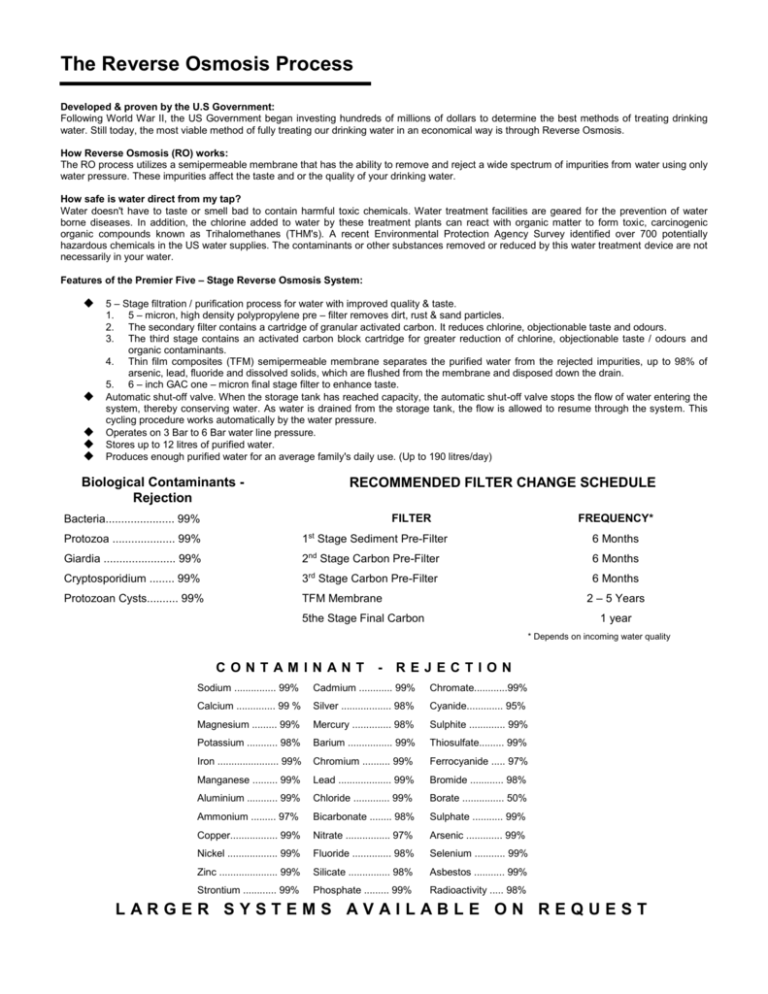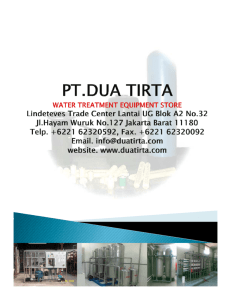The Reverse Osmosis Process
advertisement

The Reverse Osmosis Process Developed & proven by the U.S Government: Following World War II, the US Government began investing hundreds of millions of dollars to determine the best methods of treating drinking water. Still today, the most viable method of fully treating our drinking water in an economical way is through Reverse Osmosis. How Reverse Osmosis (RO) works: The RO process utilizes a semipermeable membrane that has the ability to remove and reject a wide spectrum of impurities from water using only water pressure. These impurities affect the taste and or the quality of your drinking water. How safe is water direct from my tap? Water doesn't have to taste or smell bad to contain harmful toxic chemicals. Water treatment facilities are geared for the prevention of water borne diseases. In addition, the chlorine added to water by these treatment plants can react with organic matter to form toxic, carcinogenic organic compounds known as Trihalomethanes (THM's). A recent Environmental Protection Agency Survey identified over 700 potentially hazardous chemicals in the US water supplies. The contaminants or other substances removed or reduced by this water treatment device are not necessarily in your water. Features of the Premier Five – Stage Reverse Osmosis System: 5 – Stage filtration / purification process for water with improved quality & taste. 1. 5 – micron, high density polypropylene pre – filter removes dirt, rust & sand particles. 2. The secondary filter contains a cartridge of granular activated carbon. It reduces chlorine, objectionable taste and odours. 3. The third stage contains an activated carbon block cartridge for greater reduction of chlorine, objectionable taste / odours and organic contaminants. 4. Thin film composites (TFM) semipermeable membrane separates the purified water from the rejected impurities, up to 98% of arsenic, lead, fluoride and dissolved solids, which are flushed from the membrane and disposed down the drain. 5. 6 – inch GAC one – micron final stage filter to enhance taste. Automatic shut-off valve. When the storage tank has reached capacity, the automatic shut-off valve stops the flow of water entering the system, thereby conserving water. As water is drained from the storage tank, the flow is allowed to resume through the system. This cycling procedure works automatically by the water pressure. Operates on 3 Bar to 6 Bar water line pressure. Stores up to 12 litres of purified water. Produces enough purified water for an average family's daily use. (Up to 190 litres/day) Biological Contaminants Rejection RECOMMENDED FILTER CHANGE SCHEDULE FILTER Bacteria...................... 99% FREQUENCY* Protozoa .................... 99% 1st Stage Sediment Pre-Filter 6 Months Giardia ....................... 99% 2nd Stage Carbon Pre-Filter 6 Months Cryptosporidium ........ 99% 3rd Stage Carbon Pre-Filter 6 Months Protozoan Cysts.......... 99% TFM Membrane 2 – 5 Years 5the Stage Final Carbon 1 year * Depends on incoming water quality CONTAMINANT - REJECTION Sodium ............... 99% Cadmium ............ 99% Chromate............99% Calcium .............. 99 % Silver .................. 98% Cyanide............. 95% Magnesium ......... 99% Mercury .............. 98% Sulphite ............. 99% Potassium ........... 98% Barium ................ 99% Thiosulfate......... 99% Iron ...................... 99% Chromium .......... 99% Ferrocyanide ..... 97% Manganese ......... 99% Lead ................... 99% Bromide ............ 98% Aluminium ........... 99% Chloride ............. 99% Borate ............... 50% Ammonium ......... 97% Bicarbonate ........ 98% Sulphate ........... 99% Copper................. 99% Nitrate ................ 97% Arsenic ............. 99% Nickel .................. 99% Fluoride .............. 98% Selenium ........... 99% Zinc ..................... 99% Silicate ............... 98% Asbestos ........... 99% Strontium ............ 99% Phosphate ......... 99% Radioactivity ..... 98% LARGER SYSTEMS AVAILABLE ON REQUEST






